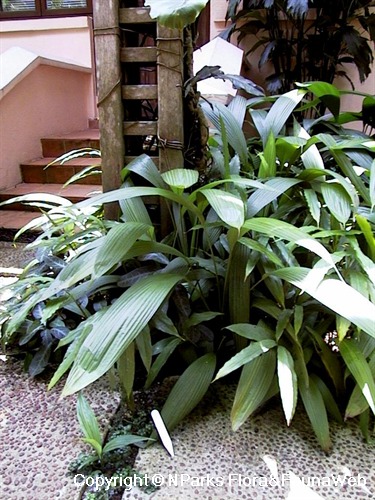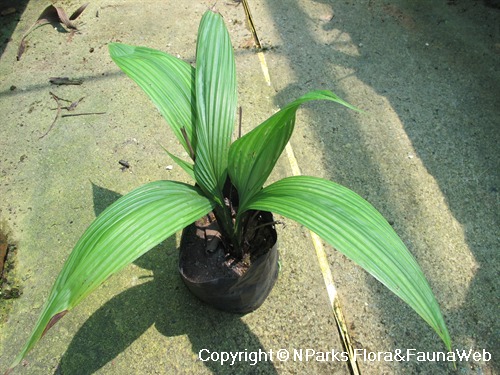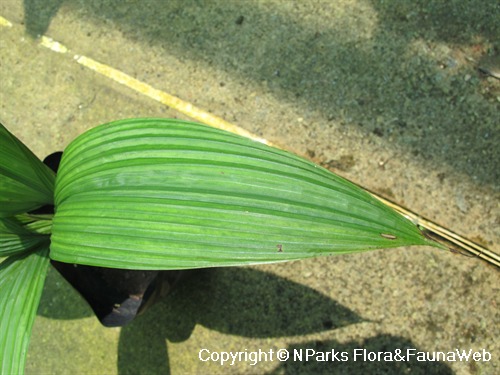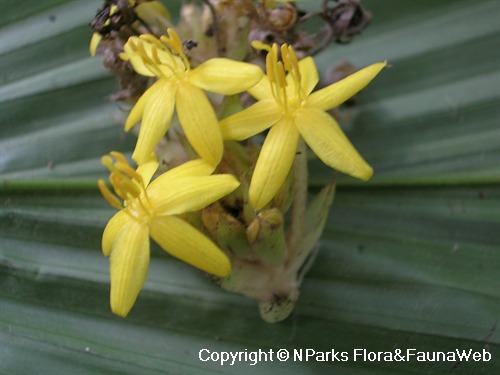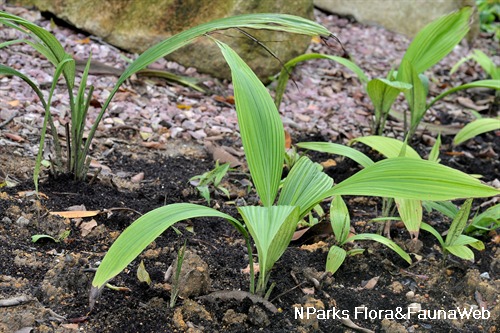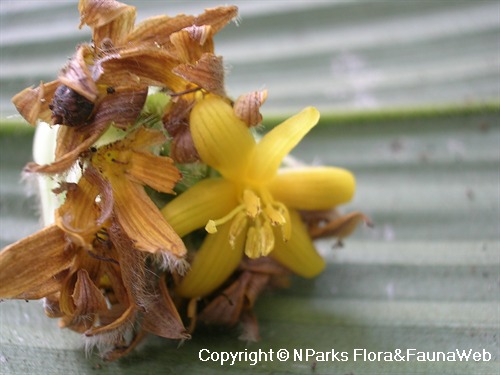
Back
Curculigo latifolia W.T.Aiton
| Family Name: | Hypoxidaceae |
| Synonyms: | Molineria latifolia (W.T.Aiton) Kurz, Curculigo villosa Wall. ex Kurz |
| Common Name: | Lumbah Rimba, Kepala Puyuh, Weevil Lily, Hill Coconut, Lumbah, Lumbah Bukit |
Name
Classifications and Characteristics
| Plant Division | Angiosperms (Flowering Seed Plants) (Monocotyledon) |
|---|---|
| Plant Growth Form | Herbaceous Plant |
| Lifespan (in Singapore) | Perennial |
| Mode of Nutrition | Autotrophic |
| Plant Shape | Fountain (Palm-like) |
| Maximum Height | 1 m |
Biogeography
| Native Distribution | India, Myanmar, Thailand, Sumatra, Peninsular Malaysia, Singapore, Lingga Islands, Bangka Island, the Philippines, Borneo, Java, and Celebes |
|---|---|
| Native Habitat | Terrestrial (Primary Rainforest, Secondary Rainforest) |
| Preferred Climate Zone | Tropical, Sub-Tropical / Monsoonal |
| Local Conservation Status | Native to Singapore (Vulnerable (VU)) |
Description and Ethnobotany
| Growth Form | It is a rhizome-bearing, hairy herb up to 1 m tall. |
|---|---|
| Foliage | Its alternate, long-stalked leaves have leaf blades that are narrowly lance-shaped, sometimes purple below, and 30–105 by 5–15 cm, with prominent longitudinal ribbing. |
| Flowers | Its bright yellow flowers are up to 1.3 cm wide, and grow on an erect, 4–10 cm-long stalk from the base of the plant. |
| Fruit | Its ovoid, hairy fruits are white, 2.5 cm long and contain many seeds. |
| Habitat | It grows in forests in hills, and lowland forests. |
| Associated Fauna | Its flowers are insect-pollinated. |
| Cultivation | It can be propagated by seed. |
| Ethnobotanical Uses | Edible Plant Parts : Edible Fruits Food (Fruit or Vegetable): The edible fruits can whet the appetite according to a report. Curculin, an artificial sweetener, is extracted from the fruits too. Medicinal: A decoction of the rhizome is used in menorrhagia and ophthalmia. Others: The leaves may be employed to pack fruits, or rolled into string. Fibres extracted from the leaves can be used to make fishing nets. |
Landscaping Features
| Landscaping | The plant looks like a young coconut palm and it has attractive bright yellow flowers. This plant is suitable for borders. |
|---|---|
| Desirable Plant Features | Ornamental Foliage, Ornamental Form |
| Landscape Uses | Parks & Gardens, Small Gardens, Flowerbed / Border, Interiorscape/ Indoor Plant |
Fauna, Pollination and Dispersal
| Pollination Method(s) | Biotic (Fauna) |
|---|---|
| Seed or Spore Dispersal | Biotic (Fauna) |
Plant Care and Propagation
| Light Preference | Semi-Shade |
|---|---|
| Water Preference | Moderate Water |
| Rootzone Tolerance | Moist Soils, Well-Drained Soils, Fertile Loamy Soils |
| Propagation Method | Seed |
Foliar
| Foliage Retention | Evergreen |
|---|---|
| Mature Foliage Colour(s) | Green |
| Mature Foliage Texture(s) | Hairy / Hirsute, Raised / Sunken Veins |
| Foliar Type | Simple / Unifoliate |
| Foliar Arrangement Along Stem | Alternate |
| Foliar Attachment to Stem | Petiolate |
| Foliar Shape(s) | Non-Palm Foliage (Lanceolate) |
| Foliar Venation | Pinnate / Net |
| Foliar Margin | Entire |
| Leaf Area Index (LAI) for Green Plot Ratio | 3.5 (Shrub & Groundcover - Monocot) |
Floral (Angiosperm)
| Flower & Plant Sexuality | Bisexual Flowers |
| Flower Colour(s) | Yellow / Golden |
|---|---|
| Flower Grouping | Cluster / Inflorescence |
| Flower Location | Axillary |
| Flower Symmetry | Radial |
Fruit, Seed and Spore
| Mature Fruit Colour(s) | White |
|---|---|
| Mature Fruit Texture(s) | Hairy / Hirsute |
| Fruit Classification | Simple Fruit |
| Fruit Type |
Image Repository
Others
| Master ID | 937 |
|---|---|
| Species ID | 2231 |
| Flora Disclaimer | The information in this website has been compiled from reliable sources, such as reference works on medicinal plants. It is not a substitute for medical advice or treatment and NParks does not purport to provide any medical advice. Readers should always consult his/her physician before using or consuming a plant for medicinal purposes. |

